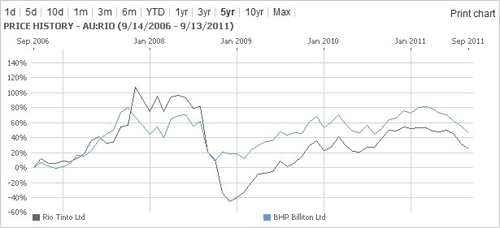9/14/2011
As mining stocks continue to be in the limelight – which one will come out on top as the winner in the ensuing battle? BHP or RIO?
The Skinny on BHP
BHP (BHP) is a massive company that is into production and distribution of petroleum, minerals, and mineral products. This includes oil and gas, aluminum, copper, silver, gold, diamonds, potash, and more.
The market capitalisation, or the value of all shares, sits around $200 billion dollars. What are some of the financial highlights of BHP? Their recent 1 year sales growth has almost tripled its 3 year average. The year over year earnings per share income is up 87.4%! Despite these high numbers, the price to earnings ratio is below the industry average at only 9.4 – and this is well below the 15 – 30 range of previous years.
The company has high net profit margins allowing it room to breathe. The 5 year net profit margin is 25.8% with the one year figure reaching up to 33.4%. Another measure of how well a company can turn a profit is with return on equity. The company generates 44.9% profit on their equity – which is higher than the 35.3% industry average.
The debt to equity ratio has dropped steadily and now sits at a healthy 0.29.
What about the future estimates? Next year’s sales are expected to grow at 12%, earnings at 18.4%, and the next 5 years at 20.46%. While these growth rates are decent, they are cooling somewhat from past years with some recent slashing of estimated earnings growth. This is going to be a hard stock to beat.
The Skinny on RIO
RIO Tinto Limited (RIO) is also a massive company, being one of the world’s largest international mining groups. They have their hands into almost everything from aluminum, copper, diamonds, coal, gold, iron ore, and more. The market capitalization of RIO is 120 billion dollars.
How does RIO compare? Sales growth has maintained strength and lies at 31.9% year over year growth. Earnings are up a whopping 143.1% year over year. Just like BHP, the price to earnings ratio is quite low for such high growth – sitting at 9.2.
Profit margins are comparable with the 5 year average lying at 20.7% and the most recent year at 28.4%. This is slightly below BHP but still well above industry averages. Their return on equity is at 29.5, which is below the industry average. It shows that they are not as efficient in use of equity.
The debt to equity ratio is identical to BHP, and they have aggressively reduced their long-term debt by two-thirds since 2007.
As we stack the two companies up they seem similar in valuations. What about future growth? Sales are expected to only climb 8% in 2012, and earnings by 8.6%. That being said, the next 5 years are anticipated as having a 40.62% pop in earnings despite forward earnings being dropped recently.
Mining Price Chart - BHP VS RIO

As you might expect, these two stocks are trading fairly close together on the 5 year chart. RIO has higher tops and lower troughs while BHP is a more consistent mover over time. If you are seeking higher risk gains, RIO might be your pick, otherwise I prefer the price action of BHP.
Dividends
Our last look will be at dividends and payout ratios. RIO is paying out a 15% of their profits to shareholders for a 1.64% yield. BHP has a slightly higher yield at 2.7% with a payout ratio of 23%. I give the advantage to BHP for dividends, although with such a high return on equity they could likely earn more my re-investing the income into the company.
The Mining Winner?
I have to give the title belt to BHP. Their return on equity (roe) is very high, they have a good track record, decent future prospects and better price stability. The smallish dividend puts a little extra money in your pocket as this oil and mineral giant lumbers forth to put your investment dollars to work. RIO is no feather weight and a very strong #1 contender for the title, and if you want the potential for higher gains at the expense of higher volatility – then be my guest. My final recommendation must stick with the champ – BHP